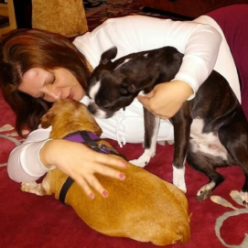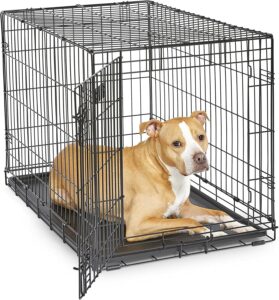In this article, we’ll discuss
We’ll also talk about some dangers and precautions for crate training. But first, let me suggest checking out Professional Dog Trainer, Doggy Dan’s Free Tutorial called, “Tips and Tools for Crate Training a New Puppy.”
Doggy Dan is a Professional Dog Trainer and Behavioral Specialist, and owner of the dog training website, The Online Dog Trainer. His tutorial will certainly be a great resource for you in addition to today’s article.
watch my video: crate training puppies
 What is Crate Training for a Puppy?
What is Crate Training for a Puppy?
Crate training a puppy is an effective tool used, most commonly, for potty training puppies. Dogs instinctively will not soil their dens, so crate training puppies helps with housebreaking.
Puppy crate training is also helpful for limiting your puppy’s access to the entire house until he learns not to chew on furniture or your belongings, and to keep the puppy safe from things that may harm him if he’s left unsupervised.
A crate is also a safe way to transport a puppy in a car, as well as keep the puppy out of the way and safe if you’re having people over or repair work done at your home.
Teaching a puppy to sleep in a crate is also a useful way to get a good night’s sleep – both for you and your puppy. For more information, read my article, Should Dogs Be Crate Trained?
Let’s talk about how to get started, then we’ll go over step-by-step instructions.
 Before You Start Crate Training Your Puppy
Before You Start Crate Training Your Puppy
Select the right crate. Crates come in different sizes and styles. You can find a nice selection of puppy crates here. Be sure to choose the correct size crate for your puppy.
It should be just big enough for him to stand up and turn around in. As your puppy grows, you may need a larger crate.
If your dog is a large breed, you may consider purchasing an adult-size crate that can be blocked off as he grows.
Check out what I’m talking about here. But a word of caution here – make sure you can block it off, so your puppy doesn’t have access to an enormous crate. If it’s too big, he’ll fee comfortable peeing or pooping in it.
Make the crate pleasant for your puppy. Your puppy’s crate should have a nice cushion on the bottom, ideally, a dog bed that fits the crate. You can find a selection of dog beds here. You should also have a toy inside the crate. You can find a nice selection of puppy-safe toys here.
Be patient. Depending on your puppy’s age, crate training can take days or weeks. Two important things to remember when crate training puppies are to always associate the crate with something pleasant, and always do crate training in small steps – not fast!
 5 Steps to Crate Train Puppies
5 Steps to Crate Train Puppies
Step 1: Introducing Your Puppy to the Crate. Put the crate in an area of the home where the family spends time, such as the living room or family room. Dogs don’t enjoy being isolated. They want to be with the family/pack!
Keep the crate door open and allow the puppy to explore the crate as he wishes. Some puppies will be curious and enter the crate right away. Others will be more apprehensive.
Using a cheerful tone of voice, invite the puppy over to the crate. Make sure the door is wide open so it won’t hit him and startle him as he pokes his head inside. Encourage the puppy to go inside the crate by putting small food treats just inside the crate…then a few deeper in.
Don’t force the puppy to go inside.
Let him take his time. Keep tossing treats inside the crate until your puppy is calmly walking all the way inside the crate to get the food. This step could take two minutes – or several days. It is crucial for you to be patient and not force it.
Step 2: Give Your Puppy All of His Meals In the Crate. This will create a positive, pleasant association with the crate. If your puppy is comfortable entering the crate, place the food dish all the way to the back of the crate.
If your puppy is reluctant to enter the crate, then put the dish just inside the crate at first – moving it a tad further toward the back of the crate at each feeding.
Once your puppy is comfortable eating all of his meals inside the crate, you can start closing the door while he’s eating. The first time you do this, open the door as soon as he’s done eating.
Then with each meal thereafter, leave the door closed just a few minutes longer…and longer…and longer…until he’s staying in the crate for about ten minutes after eating. If he starts crying, you may be moving too quickly.
If you’d like more information about puppies crying in the crate, check out this video, How to Stop a Puppy from Crying in the Crate.
Step 3: Start Leaving Him in the Crate for Short Periods of Time. Once he’s eating all of his meals inside the crate with no anxiety, whining, or fear, you can start to leave him inside the crate for short periods of time.
Call him over to the crate and give him a treat. Then point to the inside of the crate and encourage him to enter with a treat.
Give him praise once he’s inside, give another treat, and close the door. Sit quietly near the crate for a few minutes (5 or 10). Then go into another room for a few minutes.
Come back, sit quietly again for a short time, then let him out of the crate. Repeat this process several times a day if possible, increasing the length of time you’re leaving him in the crate while you’re out of his sight.
Step 4. Start Crating Your Puppy When You Leave. Once he’ll stay in the crate for about 30 minutes with you out of site, and without becoming afraid or anxious, then it’s safe to start leaving him in the crate when you’re gone from the house for short periods of time, or letting him sleep in the crate at night.
Start slowly with this. It can take several days or several weeks. Just keep practicing!
Don’t make your leaving a big, emotional thing. Just act casual – like “business as usual.” Give him a little praise, give him a treat for entering the crate. Leave a puppy-safe toy inside the crate with him, then quietly leave.
When you get home, don’t act excited and don’t reward his excited behavior. Again, act casual. This will avoid increasing his anxiety. Remember during this time to continue to crate your puppy while you’re at home so he doesn’t just associate the crate with your leaving.
Please read my post, Crate Training for Separation Anxiety, before you leave your puppy alone in the crate.
Step 5. Crating Your Puppy at Night. Use the same procedures you’re using when you leave. Direct your puppy to the crate using the regular command, and reward him with a treat once he’s inside.
If you’re crating a young puppy, you may want to place the crate near your room because he’ll have to be let outside sometime during the night to go potty until he gets older.
Your puppy, whether he’s in a crate or not, should be allowed to sleep near family members. Dogs don’t enjoy isolation.
Get More Crate Training Help from Doggy Dan
Here’s a sample video of Doggy Dan teaching his puppy, Moses, to be in his crate.
 7 Things NOT to Do When Crate Training Puppies
7 Things NOT to Do When Crate Training Puppies
1. Do not leave the puppy in the crate too long. Crating your puppy all day and night is just cruel. Puppies need as much human interaction and exercise as humans do, and just like humans, will become depressed and anxious if locked up in a cage all day.
If you have to be gone from the house for long periods of time, you need to make arrangements for someone to come and let your puppy out of his crate, let him outside, and give him some attention.
You have to be reasonable with the amount of time you expect the puppy to stay in a crate. Do not see the crate as a babysitter. If you’re not using the crate correctly, your puppy can feel trapped, upset, frustrated, and can even panic to a dangerous degree.
2. Do not use the crate as punishment. If you do, your puppy will begin to fear the crate and refuse to enter it. The crate is supposed to be his SAFE place, not a place for punishment.
3. Puppies can’t hold their bladders very long! Puppies under six months of age should not stay in a crate for more than three or four hours at a time. They simply can’t hold their bladders or bowels that long.
4. Be careful not to make crate training a traumatic experience for your puppy. You need to make sure he feels comfortable throughout the process.
5. Never leave a puppy locked up and left alone if it’s his first time inside the crate. This can be extremely traumatic for the puppy and will make it difficult (impossible!) to get him to go inside the crate from then on.
6. Don’t crate your puppy if it’s not necessary. In other words, once your puppy is house trained, and if he doesn’t destroy the house while you’re gone, then he doesn’t necessarily have to be locked in his crate while you’re gone.
Keep his crate – for his use and comfort. But you can give him free run of the house once his behavior is appropriate.
7. Don’t try using a crate to deal with separation anxiety. This will not solve the problem. It may prevent your puppy from being destructive, but he could injure himself trying to escape from the crate or panic to a dangerous extent.
If your puppy is suffering from separation anxiety, I suggest discussing it with your vet, and read this article, Treating Dog Separation Anxiety.
Patience and Consistency are Key to Crate Training Puppies
If you’re patient, consistent, and use lots of practice, your puppy can learn that his crate is a safe, enjoyable place, not a prison. If you do crate training correctly, your puppy’s crate will become his favorite place to relax!
Is Puppy Crate Training Necessary?
Some people think crate training puppies is the right thing to do, and others aren’t so sure. The folks at pawtracks.com have a nice post on the subject called, Is Crate Training Necessary?
In that post, they discuss the pros of cons of crate training, and not crate training. They also cover:
-
- Alternatives to Crate Training
- How to Potty Train a Puppy Without a Crate
I personally think crate training puppies can be very beneficial for you, and for your puppy. But only if it’s done correctly.
 Need More Help with Puppy Training?
Need More Help with Puppy Training?
Doggy Dan has several puppy training resources that each contain step-by-step videos of Doggy Dan actually demonstrating how to train your puppy.
They cover all puppy behavior issues from potty training, chewing, biting, barking, crate training…you’ll find all the help you need on his website.
I suggest taking a look at his complete program covering all puppy issues called The Perfect Puppy Program.
 I Donate to Animal Charities
I Donate to Animal Charities
Thank you for visiting my website. I’m glad you’re taking the time to learn how to crate train your puppy correctly. You’re a good puppy parent!
I donate 10% of my earnings to animal charities. You can see a list of the charities I donate to here.
If you like this website, please share it with your friends and family. Thank you! Debra


 What is Crate Training for a Puppy?
What is Crate Training for a Puppy?

 7 Things NOT to Do When Crate Training Puppies
7 Things NOT to Do When Crate Training Puppies

 I Donate to Animal Charities
I Donate to Animal Charities For More About Puppy Training,
For More About Puppy Training, 
